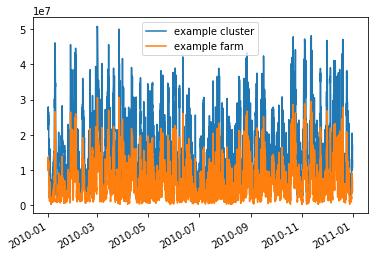TurbineClusterModelChain example¶
This example shows you how to calculate the power output of wind farms and wind turbine clusters with the windpowerlib. A cluster can be useful if you want to calculate the feed-in of a region for which you want to use one single weather data point.
Functions that are used in the ModelChain example, like the initialization of wind turbines, are imported and used without further explanations.
Imports and initialization of wind turbines¶
The import of weather data and the initialization of wind turbines is done as in the modelchain_example. Be aware that currently wind turbines need to have a power curve as some calculations do not work with the power coefficient curve.
[1]:
__copyright__ = "Copyright oemof developer group"
__license__ = "GPLv3"
import modelchain_example as mc_e
from windpowerlib.turbine_cluster_modelchain import TurbineClusterModelChain
from windpowerlib.wind_turbine_cluster import WindTurbineCluster
from windpowerlib.wind_farm import WindFarm
import logging
logging.getLogger().setLevel(logging.DEBUG)
[2]:
# Get weather data
weather = mc_e.get_weather_data('weather.csv')
print(weather[['wind_speed', 'temperature', 'pressure']][0:3])
# Initialize wind turbines
my_turbine, e126, dummy_turbine = mc_e.initialize_wind_turbines()
print()
print('nominal power of my_turbine: {}'.format(my_turbine.nominal_power))
variable_name wind_speed temperature pressure
height 10 80 2 10 0
2010-01-01 00:00:00+01:00 5.32697 7.80697 267.60 267.57 98405.7
2010-01-01 01:00:00+01:00 5.46199 7.86199 267.60 267.55 98382.7
2010-01-01 02:00:00+01:00 5.67899 8.59899 267.61 267.54 98362.9
INFO:root:Data base connection successful.
nominal power of my_turbine: 3000000.0
Initialize wind farm¶
To initialize a specific wind farm you can use a dictionary that contains the basic parameters. A wind farm is defined by its name, wind turbine fleet, and optionally also by a wind farm efficiency and the wind farm’s location.
A wind farm efficiency can be a constant value or be dependent on the wind speed. The coordinates are not being used here but are necessary if you need to assign your wind farm to a certain weather data point.
[3]:
# specification of wind farm data
example_farm_data = {
'name': 'example_farm',
'wind_turbine_fleet': [{'wind_turbine': my_turbine,
'number_of_turbines': 6},
{'wind_turbine': e126,
'number_of_turbines': 3}
]}
# initialize WindFarm object
example_farm = WindFarm(**example_farm_data)
[4]:
# specification of wind farm data (2) containing a wind farm efficiency
# and coordinates
example_farm_2_data = {
'name': 'example_farm_2',
'wind_turbine_fleet': [{'wind_turbine': my_turbine,
'number_of_turbines': 6},
{'wind_turbine': e126,
'number_of_turbines': 3}],
'efficiency': 0.9,
'coordinates': [52.2, 13.1]}
# initialize WindFarm object
example_farm_2 = WindFarm(**example_farm_2_data)
print('nominal power of first turbine type of example_farm_2: {}'.format(
example_farm_2.wind_turbine_fleet[0]['wind_turbine'].nominal_power))
nominal power of first turbine type of example_farm_2: 3000000.0
Initialize wind turbine cluster¶
Like for a wind farm for the initialization of a wind turbine cluster you can use a dictionary that contains the basic parameters. A wind turbine cluster is defined by its name, wind farms and optionally by its location.
[5]:
# specification of cluster data
example_cluster_data = {
'name': 'example_cluster',
'wind_farms': [example_farm, example_farm_2],
'coordinates': [52.2, 13.1]}
# initialize WindTurbineCluster object
example_cluster = WindTurbineCluster(**example_cluster_data)
Use the TurbineClusterModelChain to calculate power output¶
The TurbineClusterModelChain is a class that provides all necessary steps to calculate the power output of a wind farm or wind turbine cluster.
Like the ModelChain (see basic example) you can use the TurbineClusterModelChain with default parameters as shown here for the wind farm or specify custom parameters as done here for the cluster. If you use the ‘run_model’ method first the aggregated power curve and the mean hub height of the wind farm/cluster is calculated, then inherited functions of the ModelChain are used to calculate the wind speed and density (if necessary) at hub height. After that, depending on the parameters, wake losses are applied and at last the power output is calulated.
[6]:
# power output calculation for example_farm
# initialize TurbineClusterModelChain with default parameters and use
# run_model method to calculate power output
mc_example_farm = TurbineClusterModelChain(example_farm).run_model(weather)
# write power output time series to WindFarm object
example_farm.power_output = mc_example_farm.power_output
DEBUG:root:Wake losses considered by dena_mean wind efficiency curve.
DEBUG:root:Aggregated power curve smoothed by method: turbulence_intensity
DEBUG:root:Calculating wind speed using logarithmic wind profile.
DEBUG:root:Calculating power output using power curve.
[7]:
# set efficiency of example_farm to apply wake losses
example_farm.efficiency = 0.9
# power output calculation for turbine_cluster
# own specifications for TurbineClusterModelChain setup
modelchain_data = {
'wake_losses_model': 'constant_efficiency', #
# 'dena_mean' (default), None,
# 'power_efficiency_curve',
# 'constant_efficiency' or name of
# a wind efficiency curve
# see :py:func:`~.wake_losses.get_wind_efficiency_curve`
'smoothing': True, # False (default) or True
'block_width': 0.5, # default: 0.5
'standard_deviation_method': 'Staffell_Pfenninger', #
# 'turbulence_intensity' (default)
# or 'Staffell_Pfenninger'
'smoothing_order': 'wind_farm_power_curves', #
# 'wind_farm_power_curves' (default) or
# 'turbine_power_curves'
'wind_speed_model': 'logarithmic', # 'logarithmic' (default),
# 'hellman' or
# 'interpolation_extrapolation'
'density_model': 'ideal_gas', # 'barometric' (default), 'ideal_gas' or
# 'interpolation_extrapolation'
'temperature_model': 'linear_gradient', # 'linear_gradient' (def.) or
# 'interpolation_extrapolation'
'power_output_model': 'power_curve', # 'power_curve' (default) or
# 'power_coefficient_curve'
'density_correction': True, # False (default) or True
'obstacle_height': 0, # default: 0
'hellman_exp': None} # None (default) or None
# initialize TurbineClusterModelChain with own specifications and use
# run_model method to calculate power output
mc_example_cluster = TurbineClusterModelChain(
example_cluster, **modelchain_data).run_model(weather)
# write power output time series to WindTurbineCluster object
example_cluster.power_output = mc_example_cluster.power_output
DEBUG:root:Wake losses considered with constant_efficiency.
DEBUG:root:Aggregated power curve smoothed by method: Staffell_Pfenninger
DEBUG:root:Calculating wind speed using logarithmic wind profile.
DEBUG:root:Calculating temperature using temperature gradient.
DEBUG:root:Calculating density using ideal gas equation.
DEBUG:root:Calculating power output using power curve.
Plot results¶
If you have matplotlib installed you can visualize the calculated power output.
[8]:
# try to import matplotlib
try:
from matplotlib import pyplot as plt
# matplotlib inline needed in notebook to plot inline
%matplotlib inline
except ImportError:
plt = None
DEBUG:matplotlib.pyplot:Loaded backend module://ipykernel.pylab.backend_inline version unknown.
[9]:
# plot turbine power output
if plt:
example_cluster.power_output.plot(legend=True, label='example cluster')
example_farm.power_output.plot(legend=True, label='example farm')
plt.show()
DEBUG:matplotlib.axes._base:update_title_pos
DEBUG:matplotlib.font_manager:findfont: Matching :family=sans-serif:style=normal:variant=normal:weight=normal:stretch=normal:size=10.0 to DejaVu Sans ('/home/sabine/virtualenvs/windpowerlib/lib/python3.6/site-packages/matplotlib/mpl-data/fonts/ttf/DejaVuSans.ttf') with score of 0.050000.
DEBUG:matplotlib.axes._base:update_title_pos
DEBUG:matplotlib.axes._base:update_title_pos
DEBUG:matplotlib.axes._base:update_title_pos

[ ]: